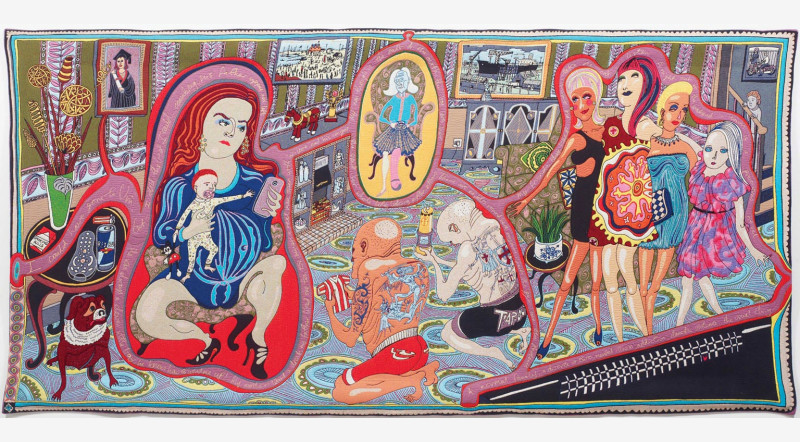Since winning the Turner Prize in 2003 Grayson Perry has risen to become one of the most influential contemporary artists in the UK. He’s that rare thing – an artist with a household name. But he also represents what people either adore or despise about contemporary art.
A recent exhibition in Dublin’s RHA displays Perry’s 2012 work The Vanity of Small Differences. The six tapestries illustrate in mesmerising detail the rise and fall of the fictional character Tim Rakewell in his quest to ascend into the upper levels of British society. Perry’s fascination with British social life is clearly apparent throughout the works. Politics, class and pop-culture are all overlying themes that the artist both critiques and satirises in a manner that provokes a range of emotions in the viewer, from humour to pathos, as we follow Tim from his adolescence to his death in a car accident.
In one image Perry depicts the cliches of middle-class life from the organic vegetables present on a kitchen table to a depiction of the Guardian newspaper. Indeed, Perry remains sharply observant of the objectively frivolous tastes of the British middle class in a way that a viewer can easily find humour in.
However, for all the tapestries wit they also contain more consequential criticisms of British society and politics. In one scene Tim is depicted as a zoomorphic character with protesters in the background brandishing posters one of which reads “no war but class war”.
Moreover, his use of imagery and colour is particularly notable giving the tapestries a macabre atmosphere as the playfulness of the images juxtaposes with the darker aspects of the work’s subject matter.
Indeed, in the final tapestry there is an emphasis on the more reprehensible themes that undercut British society as Tim, having achieved his desire to ascend to the upper classes, lies dead with blood oozing from his forehead. Around his body Perry depicts several images of consumerism from the smashed Ferrari to the logos of BP, Next, Homebase and McDonalds.
Perry illustrates the dangers of a life consumed by possessions and personal vanity. Moreover, in the background of this tapestry the silhouettes of onlookers can be seen smart phones in hand ready to beam the images of the scene across social media.
This final image remains uncomfortably relevant to society today as the pervading influence of consumer technology has, and continues to have, an impact on how we interact with the world. As a collection you cannot help but follow Tim on his upward journey through British society and feel a level of pity in his misplaced ambitions and not unrelatable desire for wealth and success. Moreover, at a visual level the works constantly conjure up new motifs, objects and questions that have the potential to maintain the viewers’ engagement. Therefore, while the subjects explored rest heavy over the fabric of the tapestries their visual complexity and sensuality makes them a pleasure to explore and interpret.







